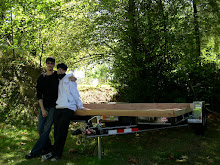Most folk jot about the day
No thought what scents
Might waft their way
And not a care
What scents they spray
Or what scents are made of, anyway.
Not Karen, though
She always knows
What's in your hair
And on your clothes
A scarf to cover
Her mouth and nose
She's chemical free
From head to toes
Karen has MCS, you see
Multiple Chemical Sensitivity
She told her dad, who still lit a smoke
Not carin' it literally made her choke
Then migraine, sinus, throat and chest pain,
And detoxing it out brings pain back again
Her dad makes her sick
It's really quite sad
But if he wants to be toxic
She can't have a dad
Her sisters love to wear per-fume,
Burn insence, and candles-not smart
Not carin' or wantin' to be told what to do
Karen's sisters are breaking her heart
She's Karen Canary, sick and afraid
Of what other people are wearin'
Most folk will just jot about their day
But those folk are not Karen.
Wednesday, December 30, 2009
Wednesday, December 23, 2009
Susie Breaks It Down
What is Multiple Chemical Sensitivity?
 People with an exquisite sensitivity to toxic chemicals are often called “canaries.” The name comes from the old practice of miners who took canaries with them into the mines; if the canary died from toxic air in the shaft, the miners had time to escape with their lives. People with chemical sensitivities are the canaries of the modern world.
People with an exquisite sensitivity to toxic chemicals are often called “canaries.” The name comes from the old practice of miners who took canaries with them into the mines; if the canary died from toxic air in the shaft, the miners had time to escape with their lives. People with chemical sensitivities are the canaries of the modern world.So how does a person develop chemical sensitivities? Sometimes exposure to toxic chemicals– maybe a one-time mega exposure or maybe a long-term micro exposure– can trigger a chronic illness called Multiple Chemical Sensitivity (MCS), where the person develops a hyper sensitivity to everyday toxic chemicals found in consumer goods and the environment.
Let’s see what the experts have to say about defining MCS. In 1999, a consensus was reached among a large group of specialists in defining Multiple Chemical Sensitivity. The abstract of their report reads:
Consensus criteria for the definition of multiple chemical sensitivity (MCS) were first identified in a 1989 multidisciplinary survey of 89 clinicians and researchers with extensive experience in, but widely differing views of, MCS. A decade later, their top 5 consensus criteria defining MCS are:
[1] a chronic condition
[2] with symptoms that recur reproducibly
[3] in response to low levels of exposure
[4] to multiple unrelated chemicals and
[5] improve or resolve when incitants are removed
[6] propose adding: requiring that symptoms occur in multiple organ systems.
These criteria are all commonly encompassed by research definitions of MCS.
Nonetheless, their standardized use in clinical settings is still lacking, long overdue, and greatly needed—especially in light of government studies in the United States, United Kingdom, and Canada that revealed 2–4 times as many cases of chemical sensitivity among Gulf War veterans than undeployed controls.
In addition, state health department surveys of civilians in New Mexico and California showed that 2–6%, respectively, already had been diagnosed with MCS and that 16% of the civilians reported an “unusual sensitivity” to common everyday chemicals. Given this high prevalence, as well as the 1994 consensus of the American Lung Association, American Medical Association, U.S. Environmental Protection Agency, and the U.S. Consumer Product Safety Commission that “complaints [of MCS] should not be dismissed as psychogenic, and a thorough workup is essential,” we recommend that MCS be formally diagnosed—in addition to any other disorders that may be present—in all cases in which the 6 aforementioned consensus criteria are met and no single other organic disorder (e.g., mastocytosis) can account for all the signs and symptoms associated with chemical exposure.
In layman’s terms, people with MCS react unfavorably when exposed to any amount, from minute to gross, of toxic chemicals from products such as pesticides, cigarette smoke, paint fumes, wood preservatives, photocopier fumes, perfumes and fragrances, laundry products, dryer sheets, air fresheners, and epoxy, among many others. Symptoms vary from fleeting to severe and might include rapid heart rate, shortness of breath, fatigue, flushing, dizziness, nausea, coughing, difficulty concentrating, problems with memory, migraine, or even life threatening seizures or respiratory distress. This chemical sensitivity condition is not rare and the numbers of people who have it are growing.
But the truth is, it’s not just chemically sensitive people who are being affected by a toxic environment. The general public is being exposed to tens of thousands of chemicals that didn’t even exist until a few decades ago. Many of these chemicals, some found in everyday household products like cleansers and cosmetics, are known to be or are suspected of causing cancer, reproductive problems, developmental disabilities, and heart disease.
People around the world are now sounding the alarm about toxic household cleansers, clothing and fabrics, electronics, cosmetics and personal care items, perfumes and fragrances, deodorizers, cleansers and soaps, all the products about which people with MCS have been alarmed for decades. But now trends are finally catching up, consumers are making smarter choices with non-toxic paints and building materials, organic gardens and foods, natural cleansers and fabrics, and electronics free from flame retardant. Until government and industry catch up with these progressive trends, the best course of action is to limit exposure and lead the healthiest life possible.
For more information about Multiple Chemical Sensitivity
For a list of citations for peer-reviewed journal articles that support a physiological basis for MCS, go to Research on Multiple Chemical Sensitivity, compiled by Professor Anne C. Steinemann and Amy L. Davis at University of Washington.
Multiple Chemical Sensitivity is recognized as a disability by the United States Social Security Administration, Department of Housing and Urban Development, and the Americans with Disabilities Act, among other government agencies. To learn more, click on the categories “Disability Rights” and “Worker’s Rights.”
To learn more about safe housing, click on Multiple Chemical Sensitivity and Safe Housing.
Click here for links to more Resources.
Click here to learn more about Multiple Chemical Sensitivity from websites around the world.
Click here to visit The Canary Report blog.
Click here to visit The Canary Report social network.
Click on a specific category or tab listed in the right hand column for more information on a given topic.
Feel free to write me, Susie Collins, editor at The Canary Report, through the Contact page.
If you feel isolated or confused with your chemical sensitivities, take heart. The Canary Report is here to give you trusted news, information and inspiration!
Friday, December 18, 2009
Getting Energized
So much for our dreams of solar power. We just can't finance it. Too bad, 'cause I'm sure it's the way to go.
But this means a friend will wire our tiny home instead of said solar guy. We are blessed to have someone we trust to do this part of our project.
We will need to find someone to hook up our propane for the stovetop and heater.
A bonfire on the property where we are building, at the beginning of a burn ban, made bad air quality worse. So we sealed the house up tight in a tarp, with some tu-tuff vapor barrier laid over the roof for extra protection from rain, and took a week off.
D K and I need to get energized, too. D K caught a cold after the roof build in the cold snap.
We need to purchase torrefied cedar siding and steel corregated roofing, along with ice and water sheild, an alternative to tarpaper.
Winter Solstice is almost here, so days will get longer and we will celebrate the Sun, though not as part of our power plans.
But this means a friend will wire our tiny home instead of said solar guy. We are blessed to have someone we trust to do this part of our project.
We will need to find someone to hook up our propane for the stovetop and heater.
A bonfire on the property where we are building, at the beginning of a burn ban, made bad air quality worse. So we sealed the house up tight in a tarp, with some tu-tuff vapor barrier laid over the roof for extra protection from rain, and took a week off.
D K and I need to get energized, too. D K caught a cold after the roof build in the cold snap.
We need to purchase torrefied cedar siding and steel corregated roofing, along with ice and water sheild, an alternative to tarpaper.
Winter Solstice is almost here, so days will get longer and we will celebrate the Sun, though not as part of our power plans.
Monday, December 7, 2009
Saturday, December 5, 2009
Wednesday, December 2, 2009
Yule Make Me Sick by Anita Bretha Freshair
I woke up cause it reeked
Of woodsmoke and dryer sheets
So cozy and static-free
My neighbor's fast asleep
I try to kindly gently say
Those are scents that cause me pain
Like acid rain on my brain
I'll share the day with another migraine.
Those are scents that cause me pain
Like acid rain on my brain
I'll share the day with another migraine.
Tuesday, December 1, 2009
Anxious for Open Air
A month since I blogged about the build, and after about 2 1/2 months of building, we have a week until possible snow.
It's December 1st and we are probably halfway done. We are hoping to be in our tiny home (parked here) by our 10th anniversary, March 2nd.
Better get to building. Update with lots of pictures coming soon...
Subscribe to:
Posts (Atom)



































